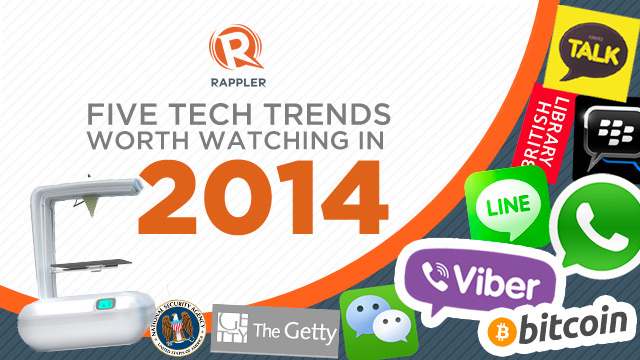SUMMARY
This is AI generated summarization, which may have errors. For context, always refer to the full article.

MANILA, Philippines – There’s a lot more to the world of technology than the consumer-focused tech many have grown accustomed to. With more people jumping into the consumer technology sphere as users, there are some important issues that may not get the attention they deserve.
This article hopes to remedy that situation with insight into 5 trends or issues that people should watch out for in 2014. These issues may become important topics of discussion in 2014, or they could easily fizzle out in the coming year.
The important thing to remember is that these tech trends are here to stay in one form or another, and it’s better to take notice and see how they evolve than ignore them outright.

3D printing
Additive manufacturing, more commonly known as 3D printing, is the process of building three-dimensional objects from a digital model by adding layers of material onto one another to build shapes or parts that can be combined to form a finished product.
The technology behind 3D printing has a wide range of uses and can be scaled to fit the needs of an individual or organization.
Large-scale uses on the micro and macro levels include medicine and rocket science. For instance, scientists were able to “print” a 3D object using human embryonic stem cells in February, which can be considered a step forward in the fabrication of transplantable organs. NASA, on the other hand, was able to create and test a rocket fuel injector, which is used to provide power to a rocket engine, using 3D printed parts.
There are also very personal or potentially commercial uses for 3D printing. Using open-source software and two 3D printers, two men worked to build a robotic hand prosthesis for a young boy in South Africa that could be scaled and reprinted to fit the child’s growing frame.
Cornell University recently released a report saying they were able to build a fully-functional loudspeaker via 3D printing, and the result is “ready for use almost as soon as it comes out of the printer.”

The communications revolution
Online communications are going beyond desktop computers and growing more commonplace thanks to smartphones and apps that allow for free instant messaging.
In addition to your standard desktop applications, some voice or messaging services have transitioned or otherwise added an app to their repertoire, such as Skype and Yahoo Messenger.
Smartphone chatting and calling apps have also grown in popularity. A short list of the commonly used ones include Viber, Whatsapp, KakaoTalk, WeChat, BlackBerry Messenger (BBM), and LINE but there are numerous niche apps out there that provide similar features for specific regions of the world. (READ: Rappler is now on LINE)
Perhaps the best proof of the spread of a wide range of communications apps happens to be the intergration or creation of messaging apps for services that do not necessarily need them. For instance, there’s the stand-alone Facebook Messenger app and the in-app Instagram Direct messaging service.

The ebb and flow of Bitcoin
Bitcoin is a form of decentralized digital currency that is gaining notice around the world because of its nature. Without getting too technical, think of Bitcoin as money that can be used to pay for good and services over the Internet without requiring a bank to facilitate the transaction.
This is done by maintaining a blockchain, a master list of all transactions done using Bitcoin as well as who owns or has owned a particular Bitcoin over time.
While there are other digital currencies out there trying to make their mark, Bitcoin has the strange advantage of being in the news a lot. Early on, this was due to how black markets for illegal or illicit goods – such as the Silk Road website – tried to use Bitcoin as the currency of choice.
From a technological standpoint, media also delved into the Bitcoin mines – servers that process the algorithms that maintain the Bitcoin blockchain. The Bitcoin mine operators are paid with Bitcoin as a result.
More importantly, there are worldwide financial implications to Bitcoin that have made it a point of government scrutiny, leading to a wildly fluctuating value for one Bitcoin. Bitcoin once reached a US$1,100 exchange rate in late November, and then sank to less than half that price by December 18, after China restricted yuan exchanges for the digital currency.

Freeing culture with tech
If the cornerstone of education and personal growth is the free exchange of ideas, then the push to make information more readily available and otherwise free is an important development worth mentioning.
There are a number of ways in which this is happening, and the Internet is helping to facilitate the spread of an open culture of information. Coursera, and Khan Academy are two of a number of websites allowing people to learn new skills and information without a fee.
There’s even a site providing free or otherwise low-cost textbooks to students online, using open source materials as the basis of the textbook information. The site, called Boundless, recently settled a suit with textbook publishers, allowing both traditional textbook makers and Boundless to continue providing students with high-quality information in their own ways.
Academics and researchers have also rallied to the cause in various ways, perhaps inspired in part by the death of Internet activist Aaron Swartz in January. Online journal storage service JSTOR now offers limited free access to everyone. Development economist Eva Vivalt has aggregated tweets and links to research PDFs from a tribute to Swartz to free research information on her website.
Lastly, Institutions such as the Getty Museum and the British Library have released more than a million images combined into the public domain.

Surveillance world
If 2012 was the year of Wikileaks and hacking, perhaps 2013 can be seen as the year of Snowden and surveillance. Following the revelations made by Edward Snowden in June and his subsequent asylum in Russia, the world sees how world powers are watching not only individuals, but each other as well.
Following the publication of documents that point to the idea that the US has been spying on its neighbors, world leaders are considering their options in a world that is technologically able to see you without needing to be near you. The US has been in a number of spying rows against France and Mexico, and German chancellor Angela Merkel is also looking for answers regarding US surveillance on her phone.
Newly-disclosed Snowden documents also reveal that US and British intelligence are spying on the world’s online games to thwart potential terrorists using games to plot attacks.
It’s a matter of fundamental freedoms versus the fear of attacks by national threats, and when it comes to world security, the fear seems to be winning out. While US legal and intelligence experts have called for an overhaul of the NSA spying program – with the experts’ recommendations found here and the full report here – their recommendations still suggest leaving some leeway for monitoring people.
That said, we’re living in a world where surveys point to people being more fearful of hackers than their maintaining their own privacy online. It may be time to be equally cautious of both. – Rappler.com
Man working on computer image from Shutterstock
3D Printer image from Shutterstock
Add a comment
How does this make you feel?
There are no comments yet. Add your comment to start the conversation.